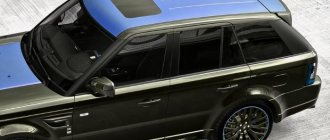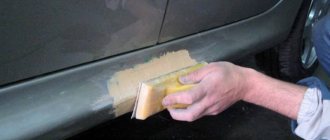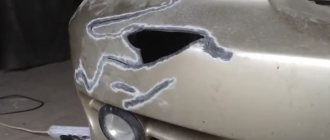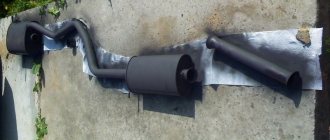Automotive solvents - what are they?
In terms of its chemical composition, an organic solvent for car painting is practically no different from other solvents for paints and enamels used in everyday life and in production. The main functions of automotive solvent come down to the following three:
- Cleaning and degreasing the surface
- Thinning the paint to the desired consistency
- Washing tools (for example, a spray gun) after work
The choice of a particular solvent for automotive paint is determined by the type of work performed, as well as the characteristics of the composition for painting and the surface being treated.
The main indicators of paint solvents for cars are:
- Appearance
- Density
- Volatility
- Water content
- Content of chemical impurities
- Degree of toxicity
- Acidity
- Flash point
- Fire danger level
The main one of these characteristics for the user is the degree of volatility, that is, the rate of evaporation of the solvent from the surface. Depending on volatility, solvents are classified into fast (they are recommended for use in winter), universal (with an average degree of evaporation, intended for use in the off-season) and slow (designed for painting a car in summer).
How to thin paint for a spray gun
The speed of paint spreading and drying depends on the external temperature. To protect and avoid bad results, manufacturers try to play it safe and recommend using each thinner at a certain temperature.
Car enamels are provided in liquid form, and when you open it, this does not mean that it is ready for application; you need to know the proportions that will allow the paint to lie easily and evenly on the metal surface.
When adding a solvent, take into account the composition of the paint, because it may already contain a certain amount of it.
You should not take measurements yourself and add solvent by eye.
Therefore, the ideal solvent for painting a car is one that:
- Used at low temperatures, the paint dries quickly, so drips do not even have time to appear.
- If the ambient temperature is within 25C, you should pay attention to a solvent with an average evaporation rate.
- If the temperature is above 25C, then a solvent with slow evaporation properties is suitable. When the paint begins to spread over the surface, the car owner will receive durable body protection.
Article on the topic: How to properly mix motor oils
If the color you choose is “pearl” or “metallic,” then you can’t think of anything better than a slow solvent.
This is the only way to achieve a uniform color and the absence of other defects.
The paint is ready and all that remains is to filter it, the most common way is to use an ordinary nylon stocking for this, only after this procedure can work on painting the surface be carried out.
What solvent should you use to thin car paint?
To correctly answer this question, you should know exactly what type of paint will be used in this particular case. Basically, all modern car paints are divided into four types:
- Acrylic - the most common option, requiring the use of a hardener
- Alkyd enamels (more rarely used)
- Nitro paints (in particular, synthetic nitro enamel with a metal effect)
- Water-based paints that have gained popularity due to their environmental qualities.
Thinning acrylic paints
Acrylic paints are water-based and produce bright, deep color. They dry quickly and are easy to apply, but before use they require mixing with a special hardener, after which they are brought to the desired consistency with a solvent for acrylic automotive paints.
As such a solvent, it is better to use a special composition designed to speed up the drying of paint and is divided into a solvent for glossy and matte paints. However, if you need to save money, a specialized solvent for acrylic paints can be replaced with solvent R-12 or 651.
Thinning alkyd paints
If you are painting a car with alkyd paints, know that solvent R-4, as well as pure toluene or xylene, are suitable for diluting them. However, it must be remembered that the relevance of using this category of paints is rapidly declining, and, due to tightening environmental standards, the use of alkyd paints may disappear altogether.
Dilution of nitro enamels
The use of nitro enamels is in demand when painting a car with metallic paint. It is applied in two layers: first, synthetic nitro enamel of a selected shade with a metallic effect, then a protective layer of acrylic varnish. It must be remembered that metallic paint is very sensitive to the selection of solvent, and therefore, when choosing which solvent to dilute metallic paint, it is better to follow the recommendations of the manufacturers of such compositions (solvent 646 is often indicated on the paint can).
At the same time, light-colored paints are the most susceptible to the quality of metallic solvents. A low-quality or unsuitable solvent for metallic paint is dangerous because metal particles will lie unevenly on the surface of the car, which will lead to the formation of stains.
In addition to the need to take into account the temperature and time of year, when working with metallic solvent, it is advisable to follow the following recommendations:
- The temperature of the car surface to be painted, the solvent and the air in the room where the work is being done should be approximately the same
- It is strictly forbidden to heat the element being processed or the paint solvent.
Dilution of water-based paints
As the name suggests, such paints can be diluted with alcohol, distilled water or ether. When choosing ether or alcohol for work, you must remember that not all mixing options are compatible, and in order to avoid problems and check whether the paint will curl, you should use the mixture on a relatively small part.
Proper paint dilution
Regardless of whether you use thinner for base or varnish, the correct ratio of base compound and thinner is an important criterion for the success of a paint job (usually the ratio of thinner and colorant is indicated on each can).
Despite the fact that the viscosity of the composition can be correlated with the specified data using a viscometer, many experts in car painting claim that of the two solutions, the one that adheres best is considered to be properly diluted.
Viscosity is directly dependent on temperature and the saturation of air with water vapor, therefore, before starting mixing, it is necessary to obtain accurate data on the air temperature in the spray booth (even a deviation from room temperature of 4-6 degrees leads to the need to change the amount of solvent added) .
You can learn how to thin car paint and varnish from the following video:
How to mix paints correctly.
Each has its own advantages and what to use is purely everyone’s choice. The measuring ruler is reusable and will last a very long time, unlike a measuring cup. Measuring rulers are double-sided (each side has different mixing proportions). Basically like this: 2:1 and 4:1 and another option is 3:1 and 5:1. How to use the measuring ruler and glass in the photo below, there is nothing complicated about it. Before mixing paints, be sure to read the instructions on the packaging in what ratio to dilute the material. Below I will tell you in what proportions to mix different paints.
Mixing acrylic paint "acrylic":
For Vika paint this is a 4:1 ratio with hardener and 20%-30% thinner. And for Mobihel 2:1 with hardener and 10% -20% thinner.
Mixing base:
The base paint is generally mixed 2:1. That is, the base itself and half of it is the solvent. It can also be mixed 1:1.
Mixing varnishes:
The story with varnishes is almost the same as with acrylics. The varnish is diluted 2:1 with hardener and thinner from 0% to 20%. Depending on what viscosity you need it. All the above mentioned figures are approximate and may vary depending on specific needs, type of work, and application technique. In general, read the instructions before use and there will be no problems.
To accurately determine the viscosity of paint, there is a special tool called a viscometer. The operation of the viscometer: the viscometer is immersed in paint, taken out and timed for how long it takes to empty. As soon as the stream begins to drip, the stopwatch is stopped.
And finally, a couple of comments and tips:
- What to do if the paint has dried or thickened? Fill it with solvent, stir, close and leave for a while.
- Do not forget about Health, solvent vapors are very volatile and poisonous, prolonged exhalation can harm your health. Use a special respirator
- How to dilute alkyd paint? Recently, alkyd paints are practically not used in car painting. You can dilute alkyd enamel with white spirit.
Base paint
The base paint should not contain a hardener. After application and drying, it is varnished.
The base paint is mixed 50 to 50. 1 part base, 1 part thinner. Some products are thinned in a ratio of 2 parts paint to 1 part thinner.
If the car will be painted with paint that requires further varnish, then more varnish may be required than base paint. It is necessary to create a certain thickness with varnish, since it is a protective coating. For example, if it takes about 2 liters of base paint to paint the body, then 3 – 3.5 liters of varnish may be required.
Read more: Why the DSG box is bad: the main disadvantages
In general, the amount of varnish depends on the area to be varnished, and not on the amount of base paint. The amount of paint and varnish may be the same.
Painting rules
Basically, 2–2.5 kg of undiluted paint is enough to paint a four-door sedan. Since the base paint is diluted 1 to 1 (1 liter of paint is mixed with 1 liter of thinner), you will get twice as much diluted paint.
If the car needs to be painted along with all the openings, then you will need 0.5 - 1 kg more paint. Since the base paint is usually diluted 1 to 1, the amount of paint diluted for spraying will be 2 times greater.
- The temperature of the air in the garage and the parts should be the same.
- Surfaces must not be heated before finishing.
- Sticky wipes help to apply the material evenly and remove dust and debris from the element before processing.
- The body is always protected with goggles, a respirator, and a special overall.
- Old body parts are used for training.
Components of quality formulations:
- Primary color pigment.
- Binder.
- Solvent.
Read more: Car airbrushing types and methods of application
Advantages of acrylic compositions:
- Affordable price and good quality.
- Applies evenly to the surface.
- Naturally sparkles.
- It lasts a long time.
- Little consumption - 200 ml per 1 sq. m.
- Does not require special skills to operate.
- Applies in a few hours.
Acrylic withstands minor impacts well, scratches do not appear.
- Highly flammable.
- Fades quickly in the sun.
- A thin layer is applied several times.
Many acrylic enamels consist of 2 components, and in order for the mixture to dry on the body, a hardener is added, and varnish is applied in rare cases.
Glypthal dry slowly, are better absorbed at high temperatures, and polymerize in 2 to 4 weeks.
Alkyd enamels are difficult to polish and it is difficult to achieve shine. They take longer to dry, require heating, and collect dust. Suitable for use in professional workshops.











